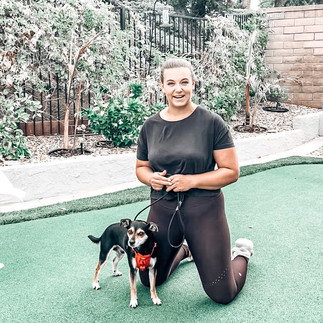How to Walk Your Dog Correctly Featuring Carly Trimble
- Tiffany Dnaka

- May 3, 2022
- 4 min read
Updated: May 31, 2023
Walking your dog is not just a routine chore; it's a valuable opportunity for exercise, mental stimulation, and bonding. However, many dog owners may not be aware of the importance of walking their furry companions correctly. In this blog post, we will guide you through the key steps and considerations to ensure that your dog's walk is both enjoyable and beneficial for their overall well-being. A few weeks ago I had a private 1-1 session with Carly Trimble from Reward Calm Dog Services located in Orange County, CA. Carly is a holistic dog trainer, with years of expertise under her belt!
When I came to Carly, I told her my biggest problem with Finn is that he doesn't seem to be focused on our walks. Finn is a rescue dog and when we walk he is constantly scanning the environment. Physically he is there, but mentally he is distracted.
Carly places a slip lead on Finn, notice that she places it right below his ears.
6 Tips on How to Walk Your Dog Correctly
Start with Proper Equipment:
Before heading out for a walk, it's crucial to have the right equipment. Invest in a sturdy leash that is comfortable for both you and your dog. Consider the appropriate leash length based on your dog's size and behavior. For instance, a retractable leash may be suitable for a well-trained dog, while a standard 4-6 foot leash is often recommended for better control and safety.
Set the Pace:
Maintaining a consistent pace during the walk is important. Dogs, especially high-energy breeds, benefit from a brisk walk that gets their heart rate up. However, remember to adjust the pace to your dog's abilities and physical condition. Older dogs or those with health issues may require a slower, more leisurely walk. Observe your dog's behavior and adjust the speed accordingly to ensure their comfort.
Practice Proper Leash Etiquette:
Teaching your dog proper leash manners is essential for an enjoyable walking experience. Encourage your dog to walk beside you on a loose leash rather than pulling or tugging. Reward good behavior with treats or praise, reinforcing positive walking habits. If your dog starts to pull, stop walking and wait until they return to your side. Consistency and patience are key when training your dog to walk politely on a leash.
Choose the Right Walking Environment:
Consider your dog's needs and preferences when selecting a walking route. Dogs thrive on mental stimulation, so exploring different environments with varied sights and smells can be enriching. However, be mindful of the weather conditions and temperature. During hot summer months, opt for walks in the cooler parts of the day, and in extreme weather, consider shorter walks or indoor activities to keep your dog safe and comfortable.
Allow for Sniffing and Exploration:
Dogs experience the world through their sense of smell, and allowing them to sniff and explore their surroundings is crucial for their mental well-being. While it's essential to maintain control and direction during the walk, providing opportunities for your dog to investigate new scents and environments helps satisfy their natural curiosity and mental stimulation needs.
Incorporate Training and Exercise:
Walking time can also be used for training and exercise. Incorporate basic obedience commands, such as sit, stay, and heel, during your walk. This not only reinforces your dog's training but also engages their mind and encourages focus. Additionally, consider adding short bursts of running or interactive games like fetch to provide extra physical exercise, especially for high-energy breeds.
With that being said, here is a short 2-minute clip of how we tackled structured walking.
Here are a few things I learned
1. I changed Finn's walking equipment from a harness to a slip lead. The slip lead gives me more control over him when I'm walking or training. Don't get me wrong, I still use the harness i.e., in the car to safely buckle him or on bike rides. For me, the slip lead is a tool to use to train him. I use it with minimal pressure as I do not want to hurt/damage his throat.
2. The best environment to train your dog is either with a professional trainer like Carly, or in a controlled environment. Too much external stimulus can induce anxiety or distract your pup. Imagine trying to learn without a teacher and that your classroom is directly in front of a circus. It would be pretty hard to learn. Dog trainers are subject matter experts and can deliver results in minutes.
3. Walks should be structured like an ice cream sandwich! The first layer should be structured; the middle should be the rewarding part of the walk (allow for sniffing, exploring etc), but only if the dog has earned it. The last part of the walk should be structured.
Thank you Carly! She also offers virtual training for those who are outside of the Orange County Ca, area. Contact: carly@rewardcalmdogservices.com (630) 621-0004
If you enjoyed reading this blog please give it a share. Be sure to follow me on Instagram to stay caught up with the latest features and events! This blog was written by Tiffany, your custom pet portrait artist!








Thank you Carly!! love, Finn